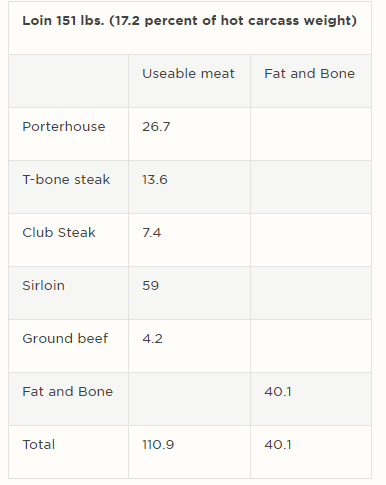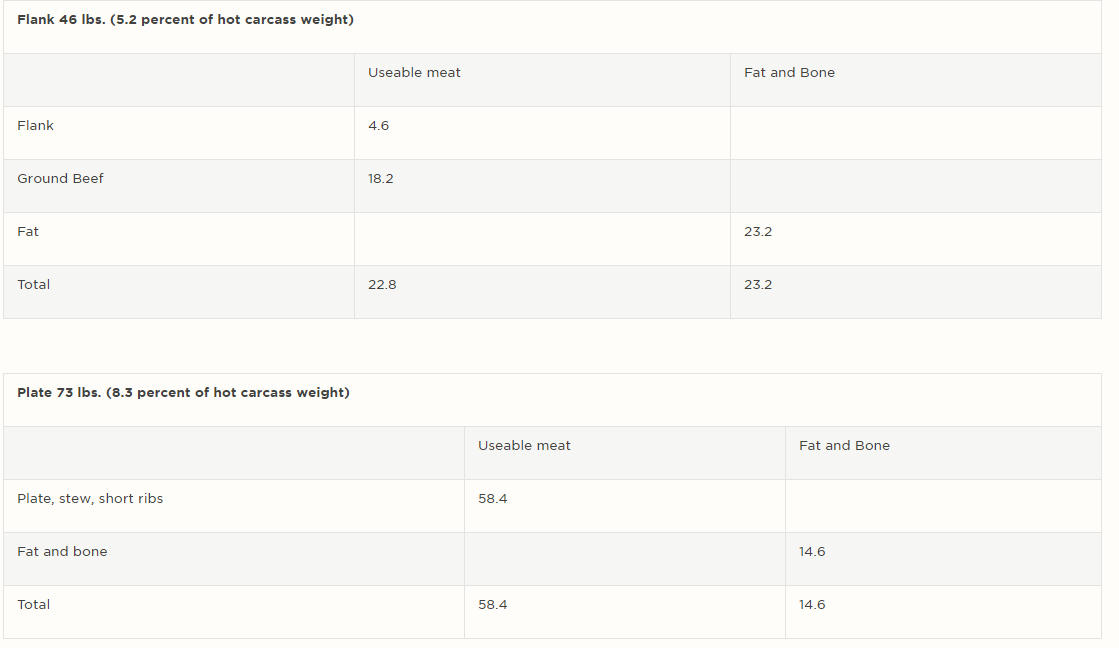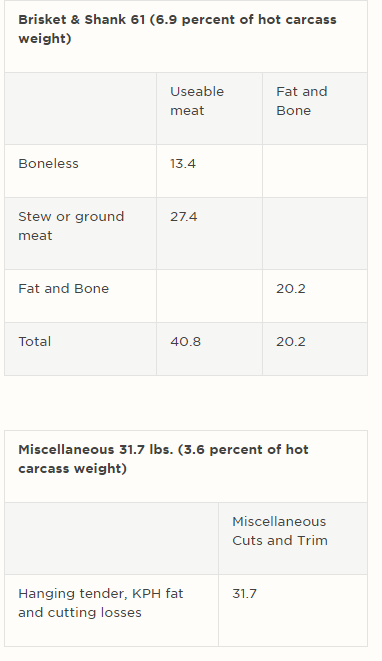



How Many Pounds of Meat Can We Expect From A Beef Animal?
Consumers who buy a live animal from a local cattle producer or 4-H member for custom processing are often surprised by the amount of beef they receive, the amount of freezer space needed and that they did not get back the entire live weight of the animal in retail cuts.This article will discuss how to estimate how much meat you will receive when purchasing an animal to harvest.
Dressing Percentage is an important term to remember as it represents the portion of the live animal weight that transfers to the hot carcass weight.
Dressing percentage is calculated as: (hot carcass weight ÷ the live weight) x 100.
The hot carcass weight (HCW) is the weight of the unchilled carcass in pounds after the head, hide and internal organs have been removed. For most fed cattle, the HCW will be approximately 60 to 64 percent of live animal harvest weight. For example, a 1400-pound animal with a hot carcass weight of 880 pounds has a dressing percentage of approximately 63%, which is calculated as follows:
(880 hot carcass weight ÷ 1400-pound live weight) x 100 = 63%.
It is not uncommon for the buyer of a live animal to question, “The dressing percentage of my 1400-pound steer was 63% but I only got 550 pounds of meat – where is the rest of my meat?” The calculation of dressing percentage is based on hot carcass weight. The hot carcass weight includes bones, excess fat and moisture loss that will not be packed and wrapped for home consumption. The hot carcass weight is not the actual amount of meat that the consumer will put in his or her freezer.
Many factors can affect the dressing percentage. Anything that adds weight to the live animal but does not appear on the carcass will lower the dressing percentage. Factors that might add to the live animal weight but not be included in the hot carcass weight include:
- Hide
- Horns
- Pregnancy
- Mud and/or manure on the hide
- Gut fill
All beef animals are not created equal. Therefore, the dressing percentage is not consistent from one animal to another. Some of the primary factors that influence the dressing percentage include breed of the animal (dairy vs beef), live weight and how it was finished (grain fed or grass fed). The table below shows the relative dressing percentage for various types of beef animals and background conditions.
A beef carcass is composed of 70 to 75% water. As it is chilled, water evaporation will cause the carcass weight to decrease. It is not uncommon for a chilled carcass to weigh 2 to 5% less than the hot carcass. That means our example 880-pound carcass could lose nearly 40 pounds during chilling solely due to water loss by evaporation!
After a carcass is cooled, it will be further processed into the retail cuts you bring home. The carcass is split in half, and further separated into “primal” (or wholesale) cuts. This process is referred to as “breaking down the carcass or fabrication.” Beef primal cuts in the front-quarter include the rib, chuck, shank, brisket, and plate; while the hind quarter is composed of the flank, round and loin (short loin and sirloin). The table below shows the typical weights and percent of a carcass of various primals from an 880 lb. carcass.
Wholesale or primal meat cuts will be further processed into sub-primals or retail cuts. The basic concept of fabricating beef retail cuts is to separate tender muscles from less tender muscles, thick muscles from thin muscles and fat from lean portions. What remains when bone and fat are removed is referred to as yield, or the percent of boneless, closely trimmed retail cuts. For example, according to the National Cattlemen’s Beef Association publication entitled “Beef Cut: Primal and Sub primal Weights and Yields,” the round typically makes up 22% of the hot carcass weight. For an 880 – pound carcass, the round would be approximately 194 pounds. About 20 percent of that weight is made up of fat and bone. This leaves approximately 155 pounds of meat, including steaks, roasts, and ground product, that will be packaged for consumption.
Factors that affect yield of retail cuts include:
Carcass Fat – External carcass fat, or backfat, has the greatest impact on the percent of retail product from a carcass. As more fat is trimmed away from the retail cuts, less weight will be included in the final packaged product; thus, a lower percentage of retail cuts.
Carcass Muscularity – Superior carcass muscling can increase the yield of a carcass. Dairy – type animals with lower lean-to-bone ratios typically yield lower than beef type animals.
Cutting style or cutting directions given to the processor can affect carcass yield. For instance, the amount of bone-in versus boneless cuts, trimming of retail cuts and the percent of fat of the ground beef will affect retail yield.
Aging – the two major advantages of aging meat are improvement in tenderness and enhancement of a “beefy” flavor. A typical aging period of seven to fourteen days allows for tenderness development. Long term aging also can have a negative effect on carcass yield as it results in more weight loss from the carcass due to further moisture loss.
In summary, the amount of meat that is cut and wrapped for consumption will be much less than the live weight of the animal. A 1400-pound beef animal will yield a hot carcass weight of approximately 880 pounds. Once cooled, the carcass weight will be approximately 840 pounds. When deboned and trimmed, there will be approximately 570 pounds of product to fill your freezer.
It is important to remember that fat, bone and trim that is discarded from the carcass are not simply thrown away. These products are known as byproducts and can be used in various industries across the spectrum. From leather, pet food, and fertilizer to medical equipment, cosmetics and sporting equipment; the value of a harvested animal stretches far past your freezer.
It is important to understand that these numbers will vary based on many factors. Not all harvested animals weigh 1400 pounds. Some may be harvested at 1100 pounds and some at 1500+ pounds. Some animals may be dairy type and others may be beef type. Some may be grass finished and some may be grain finished. All these factors contribute to how much meat you take home.
When deciding to purchase an animal for harvest, keep in mind the space you have available for safe and effective storage. A quarter of beef takes an approximately 4.5 cu. ft. of chest freezer or a 5.5 cu. ft. upright freezer. A side (half), requires around 8 cu. ft. of space, while a whole beef will need 16 cu. ft.
To summarize: A 1,400-pound steer, one-half inch fat, average muscling, yields an 880-pound carcass. The 880-pound carcass yields approximately:
- 570 pounds boneless trimmed beef;
- 280 pounds fat trim and bone;
- 32 pounds of kidney, pelvic, and heart (KPH) fat, trim loss and carcass shrink.


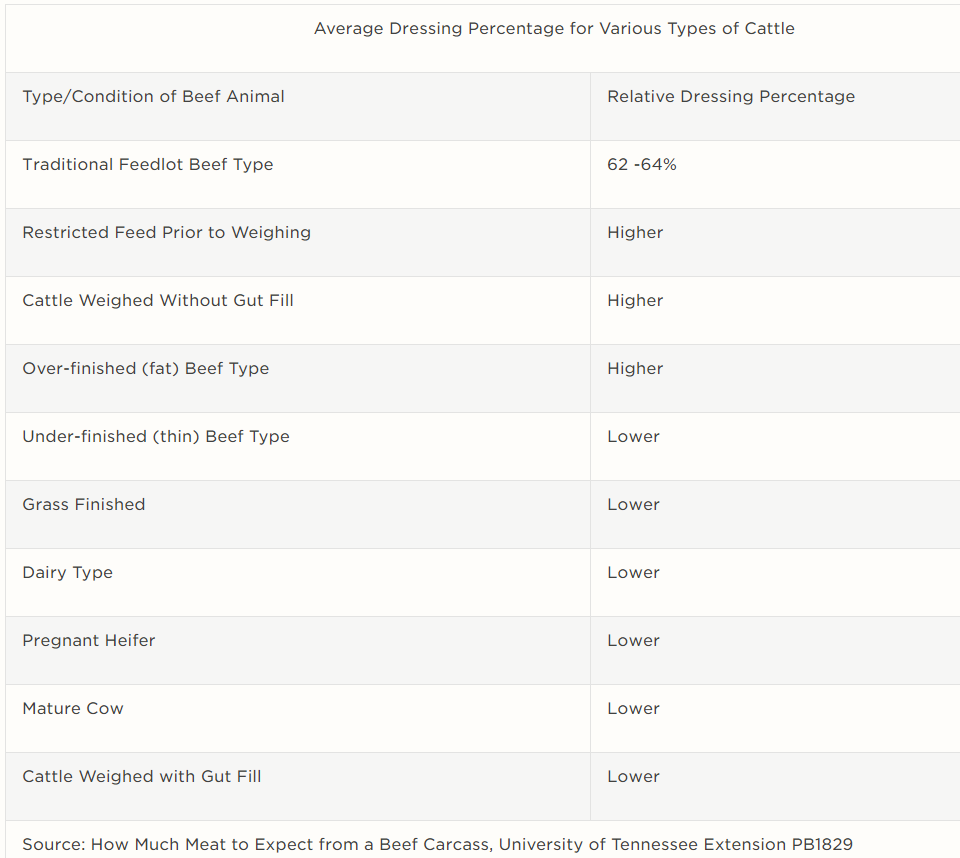
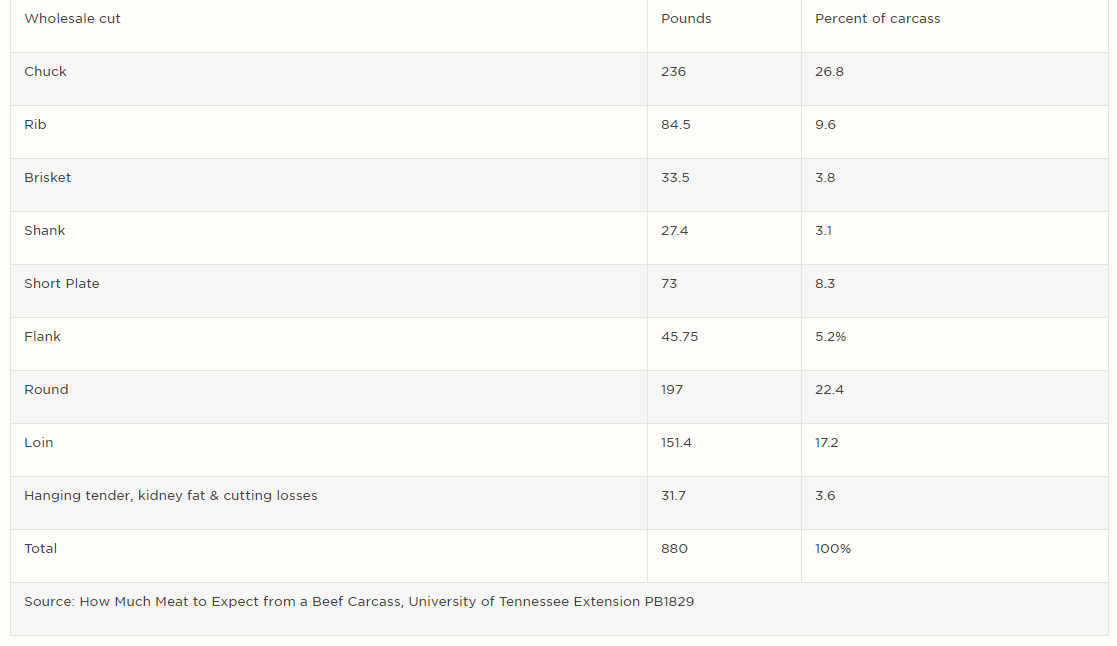

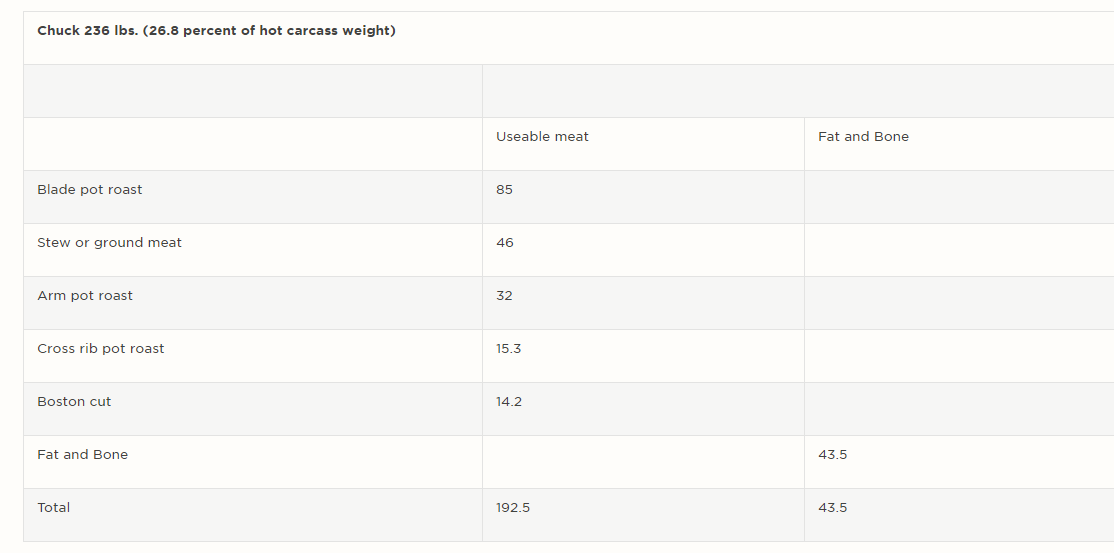
.PNG)
